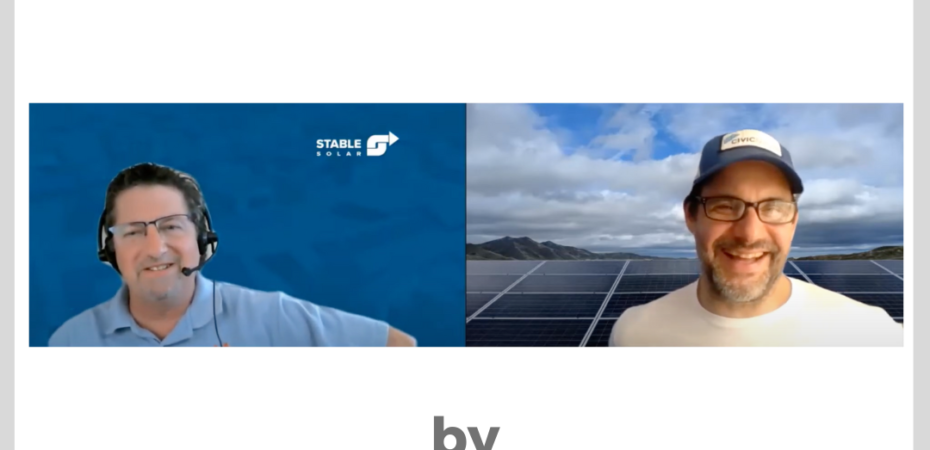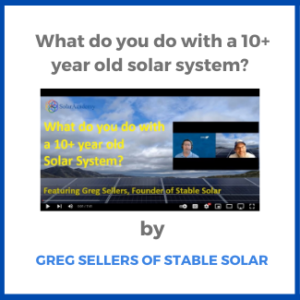In this video Kerim Baran of SolarAcademy talks with Greg Sellers of Stable about the business of taking care of 10+ year old solar systems. They look at the difficulties that come with replacing and expanding old solar systems and the business possibilities available in this rapidly growing segment of the solar industry.
Transcription of the video:
Greg Sellers: I have a homeowner that has a 175 watt panels that are out. He wants to replace them. He replaced the inverter and now he’s like, can I replace my panels? I realize that the issue is I think the manufacturer’s still in business in this case, which is, in a lot of times, not the case. I’m going to call the manufacturer and say, “Hey how about the 175 watt panels?” and they’re going to be saying like, “What are you nuts? We haven’t made anything that small!”
SolarAcademy: We’re not making 350 watt panels!
Greg Sellers: Yeah so, it was fun because I gave him some options. He upgraded his inverter so we were able to do almost as many panels but now they’re between 340 and 440 watt panels so he’s getting a whole lot more power out of it. But now he wants to go back and say, “Hey is it still under warranty?” and I’m going to check.
SolarAcademy: Is he going to end up buying the panels?
Greg Sellers: He probably will, that was his first inclination. His other issue is that the panels technically still work so I don’t know if he can be covered under warranty. In this case can he keep those and add some more 350 or 340 watt panels alongside the 175s. You could do a hybrid actually, now that i’m thinking about it, because there’s two the way the inverter is set up. I think that it might allow for that the the big issue is the inverter because if it’s got two different inputs, because he only has one inverter, so generally you’re going to have two inverters, two arrays and they’re all completely separate.
But the point is that I think it’s something for consumers to be aware of if they’ve got a system under warranty. Anything over 10 years and it’s going to be a matter of how in the heck am I going to replace? What am I going to replace it with because technology is evolving so much?
So in San Francisco I saw this system that was actually not that close to the ocean. I mean it’s San Francisco so everything’s close to the ocean. But i think it was like in in Bernal or something, but it still got plenty of sea mist.
SolarAcademy: Afternoon fog.
Greg Sellers: Yeah. So it had microinverters, very early gen microinverters from Enphase and it was good and bad. I couldn’t get on the roof next to the system but I could see from where I was about 10 feet away that there had been a significant, you know. But then I looked at the performance of the system. I went and looked at the utility bill and it was like, man, this thing is still actually, you know. They’re all metal boxes that were underneath. And Enphase doesn’t do that – it is a completely different look and profile and everything. But it was fun to see that they were still working, on the one hand, but on the other hand it’s like you know you’re going to replace it with a completely different product that you’re looking at.
So that’s something for people to keep in mind is that you’re going to be replacing it, it is not just a matter of is the warranty still valid. It’s how can I get that? The last thought on that, which I think is going to be another thing in the industry for us to think about, you were talking about it is going to be a next trend. I think that’s absolutely right but after that or as part of that I think we really need to start focusing on not only recycling.
The Department of Energy has announced a huge initiative now to try to recycle panels, which is great. But also just refurbishing and repurposing or reusing – there’s a whole spectrum of things that we can do with with systems that go well beyond. So i think it’s just thinking about it more and for us because a lot of times we’re going to be the last ones to touch the equipment so what we do with them is going to be the difference if we decide to throw them away. I think its something to keep in mind. Good stuff.
SolarAcademy: That’s something that I was discussing at a breakfast meeting today, the fact that we’re probably somewhere between half a million to three quarters of a million systems being installed right now on residential per year. In the US the total stock is probably close to three million homes – I would say somewhere between two to three million homes but I think very soon, assuming 60 to 70 million homes actually go solar – which is like 60 to 70 percent of the of all homes in the US and assuming the lifetime of these panels are 30 years and assuming a normal distribution and assuming you replace 130th of the stock every year that’s probably going to be some somewhere around 2 million to 3 million systems being replaced every year, right? Being built every year and then being replaced every year too.
That’s multiple times what the market is right now and that’s multiple times – I mean it’s like roof replacements. In the US there’s probably three to four million roof replacements happening in the US every year and along with that they’ll be happening that many solar system replacements. Not right now, but probably in 10 years.
Greg Sellers: On an annual basis. When you start looking at it in those numbers. We did calculations a few years ago for our finance plan and I went back and looked at them today and remembered what we estimated. I think it’s pretty much on track that a little over a million systems would be owned by homeowners of that total you were talking about as of this year. But in two years it’ll double
SolarAcademy: The solar market has been doubling every two to three years for the last 30 years. This has been happening but it’s only now big enough that people are noticing because it started from like zero point zero zero zero one percent of all energy but now it’s like close to three percent of all energy. That’s going to continue doubling every two to three years going forward.
Greg Sellers: Yeah, it’s fun to see now with the majority of systems, the homeowners own them. It’s still frustrating, I think we have such a long way to go. We want to spend more time educating homeowners and that’s got to be a huge part of what we do.
SolarAcademy: And technicians too.
Greg Sellers: And technicians, right, because they just don’t know what they don’t know. The lack of knowledge of solar installations across the board is so profound um. I think back, I always kind of remind myself that when people had horses and buggies nobody knew what a carburetor was or what the internal combustion engine components were and all these things that we take for granted now. But we’re getting there. It’s gonna accelerate, so we’ll keep up the good work and we’ll get there eventually.
SolarAcademy: All right, well, thanks for sharing all this information.
Greg Sellers: Great sure, it’s fun Kerim. Thank you.


